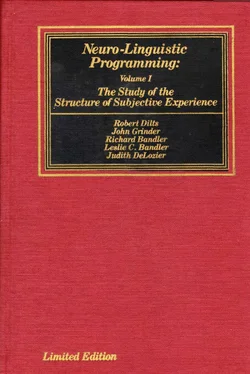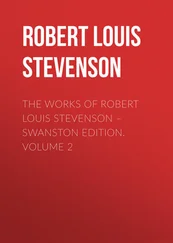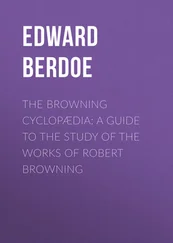The power and usefulness of strategies lies in the the fact that they are descriptions of the purely formal operations of our behavior and are not tied to any particular experiential content. As we mentioned earlier, the same strategy people use to motivate themselves to get out of bed in the morning may be utilized to motivate them to work more efficiently, to learn something new, to go jogging, to sign an agreement or even to buy a car. Our strategies provide the frameworks within which we incorporate and interpret the content of our sensory experience.
The behavioral significance of any particular experience we encounter — that is, whether it becomes a resource or an obstacle, a decision variable or an environmental variable — is totally dependent on how we utilize it within the strategies and operations we have available to us; we can choose to transform our obstacles into resources, as in the case of the waterfalls or the bread mold mentioned in the introduction. A particular content fact, is of no use to us unless we can process it through a strategy to achieve some outcome. Having the part we need to fix our car is useless to us if we don't know what to do with it.
Any past or future experience can serve either as a block or a resource, depending on how you make use of it through your strategies. Whether learning or coping comes to you with ease or with difficulty, or is rapid or laborious for you, is determined by the formal frameworks provided by your strategies.
By paying attention to context and by packaging experience in terms of the most appropriate and resourceful strategies for each situation, anyone can greatly expand their repertoire of choices and behaviors.
Our primary means of utilizing a strategy is through packaging and presenting the content of the situation or task in question in such way as to pace the steps and sequence of an appropriate strategy that we've elicited from a client. The process of pacing, first introduced in Patterns I, has been an extremely important part of all of the work we have done.
Pacing is the process of feeding back to a client, through your own behavior, the behaviors and strategies that you have observed in them — that is, by going to their model of the world. You will have successfully paced a person's strategy when you have packaged the information which you are working with (whether it is mathematical formulas, how to work camera equipment, making fiscal policy, information about some product you want to market, a personal problem the individual has, etc.) such that the form of your presentation matches, step for step, the sequence of representations the person cycles through in that strategy.
For example, consider the following strategy for decision making:

This is a fairly simple decision strategy. The initial gathering of information involves looking at the possibilities (V). This information is then discussed or described verbally through internal dialogue, or the individual recalls verbal information (A i d) concerning what s/he sees. This is then tested (against other remembered dialogues) and the results are represented through a kinesthetic (K i) response — through the person's feelings about what s/he hears or says inside his or her head. If the feelings are congruent with the words (that is, if they are definitely positive or negative) the individual will decide either for or against acting on the experience that has been proposed. If the feelings indicate an incongruence about the action the individual will operate by looking again at the situation, or perhaps by looking for alternatives (V), and the strategy will repeat itself. Note that we leave oft" the superscript of the V component of the decision making strategy — if the possibility(s) or alternative(s) to be decided among can be displayed easily externally (e.g. deciding three types of carpets — all available inside the store), then the superscript will be V e. If the possibility(s) or alternative(s) is difficult to display externally, the formulation would be V i.
If you are involved in a decision making process with this person, or if an outcome you desire depends on a decision made by this person, and you have elicited this as his strategy, you will want to utilize it by sequencing and organizing the information that you are presenting to be decided upon so that it matches the form of this strategy step for step. That is, you will first want the individual to see clearly or get a good picture of what you are talking about (rather than go into a long verbal explanation or description, or have him get a feeling for what you are talking about). You will then want to direct him, and give him time, to internally talk about what he sees. Finally you will want to make sure that he checks out his feelings about these verbal thoughts.
For instance, you might pace the strategy with your verbal communication in the following way: "I think you should really take a good look at this, so you can see how it will fit into the whole picture (V). I'm sure you'll find that it will answer the questions we've all been asking (A i d) ourselves, and you'll really be able to say, "Yes, this is the one!" You'll feel (K i),as I do, that this is the most solid and grounded choice available."
At the same time that you are presenting this verbal pace you can strengthen the effect in a powerful manner by pacing non–verbally. First, as you verbally present each of the steps of the strategy you use your hands to direct the person into the appropriate accessing posture. For example, as you say, "… really take a good look… . you can see …" you capture his visual attention by movements of your hand and then move your hand up and to your right. This will cause the person to look up and to his left (assuming you are facing one another), thereby placing the person in the appropriate accessing posture to, indeed, allow him to . . take a good look… ." At the point where you say, "… questions we've all been asking …", you would move your hand down and to your right, thereby directing the person's eyes down and to his left. Such supporting non–verbal maneuvers greatly add to the effectiveness of pacing communications.
By packaging information this way you will be making your communications maximally congruent with the other person's model of the world and behavioral strategies. Mirroring a person's thinking processes with your communication will often, in fact, make the outcome that you are proposing through your communication irresistable to the individual. A person can't not respond to his or her own strategies.
The following are a couple of exercises that we often have people in our seminars practice as a means to learn how to utilize strategies. Try them out for yourself and notice what kind of responses you get so that you may begin to sharpen your ability to identify strategies and use them effectively.
EXERCISE A:
Step 1. Elicit a creative strategy from someone by finding out what his internal processes were at some time when he was being very creative. Through questioning and observation determine the sequence of representational systems applied by that individual that lead to the creative outcome.
Step 2. Have the individual identify some area or incident in his life or current experiences in which he becomes stuck or blocked, or in which he would like to have more choices of behavior.
Читать дальше












